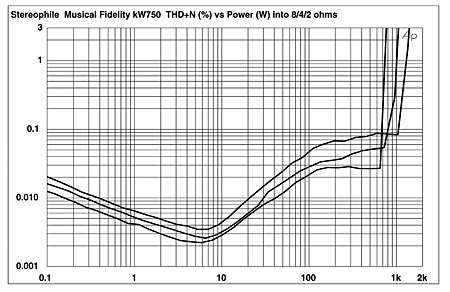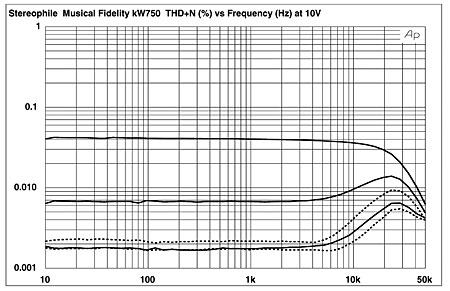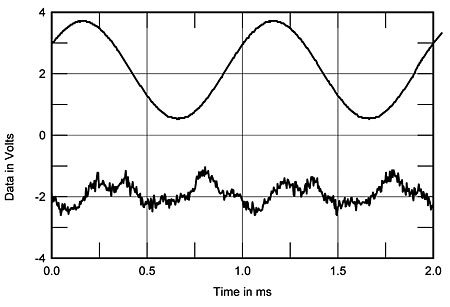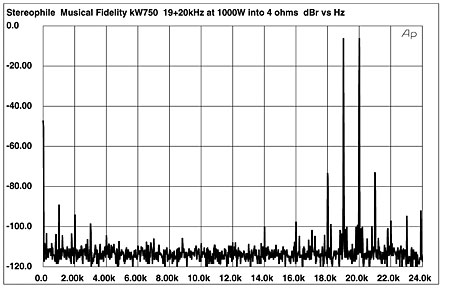| Columns Retired Columns & Blogs |
Musical Fidelity kW Hybrid line preamplifier & kW750 power amplifier kW750 Measurements
Sidebar 4: kW750 Measurements
Turning to the Musical Fidelity kW750, I preconditioned the amplifier by running it at 250W into 8 ohms for about 35 minutes, by which time my dummy load was too hot for safety. (It was also when the amplifier's illuminated feet changed from orange to blue.) The kW750's chassis and heatsinks were very hot, implying that they are only just large enough to pass the FTC heat test. The THD+noise at this power level was 0.02% with the amplifier cold, dropping to 0.013% after five minutes, 0.01% after 15 minutes, and returning to 0.017% after 25 minutes. The THD percentage then slowly moved back and forth between 0.012% and 0.017% with a time constant of around three minutes. I doubt that this is meaningful, but I thought it worth noting.
The Musical Fidelity's voltage gain into 8 ohms measured 30dB, a little higher than usual. Its input impedance was 21k ohms across the audioband, lower than the specified 100k ohms, and the amplifier was noninverting. The output impedance was relatively low for a bridged design (though high for a solid-state amp), at 0.2 ohm in the bass and midrange, rising slightly to 0.3 ohm at 20kHz. The interaction between this impedance and that of our simulated loudspeaker resulted in ±0.25dB of frequency-response variation (fig.7, top solid trace at 2kHz). Fig.7 also reveals a slight (0.15dB) imbalance between the channels.

Fig.7 Musical Fidelity kW750, frequency response at 2.83V into (from top to bottom at 2kHz): simulated loudspeaker load, 8 ohms, 4 ohms, 2 ohms (1dB/vertical div., right channel dashed).
The kW750 has a wide small-signal bandwidth, the response being –3dB at a very high 141kHz. This was into 8 ohms; the bandwidth decreased slightly with decreasing load impedance. Into 2 ohms, for example, the –3dB point lay at 53kHz, associated with an output down 0.75dB at 20kHz. The wide bandwidth resulted in superb squarewave reproduction, with short risetimes and no overshoot or ringing. Fig.8 shows a 10kHz squarewave into 8 ohms, for example. Channel separation (not shown) was better than 100dB below 2kHz, but decreased above that frequency to reach 80dB at 20kHz. Background noise was superbly low, the A-weighted signal/noise ratio measuring 96.9dB. The unweighted, wideband figure was lower, of course, but was still excellent at 78.9dB. Given that these ratios are referenced to 1W into 8 ohms and the amplifier is specified as delivering 750W of unclipped power, or 28.75dBW, into that load, the kW750 has an extraordinary dynamic range—better than 16-bit digital, for example.

Fig.8 Musical Fidelity kW750, small-signal 10kHz squarewave into 8 ohms.
Fig.9 shows how the THD+N percentage changes with output power. The amplifier clips (1% THD) at 750W into 8 ohms, to specification. I got slightly lower power into 4 ohms than specified with both channels driven—1010W (27dBW) rather than 1100W—but my AC line voltage had sagged appreciably at this point, from 125V to 119V, even though my test lab is powered from a dedicated 20A line. The shortfall in power is inconsequential. And into 2 ohms with one channel driven, the kW750 delivered 1350W (25.3dBW), the wall voltage again dropping to 119V.

Fig.9 Musical Fidelity kW750, distortion (%) vs 1kHz continuous output power into (from bottom to top at 1W): 8, 4, 2 ohms.
The minima in the fig.9 traces between 6W and 8W suggest that below this level, any distortion in the amplifier's output lies below the noise floor. I therefore ran my plot of THD+N against frequency at 10V rather than the usual 2.83V (fig.10). The usual small rise in THD above the audioband is evident, but more interesting is the difference in behavior between the channels. The right channel hardly changes its very low level of THD+N between 8 and 4 ohms (dotted traces). In contrast, the left channel's THD+N (solid traces) increases each time the load impedance is halved, though not to any extent that might be thought subjectively significant.

Fig.10 Musical Fidelity kW750, THD+N (%) vs frequency at 10V into (from bottom to top): 8, 4, 2 ohms (right channel dashed).
Figs.11 and 12 show that this increase is associated with a change from predominantly second-harmonic distortion to third-harmonic as the output current doubles. But even at very high powers, the harmonics don't rise to a level that might be audible. Fig.13, for example, shows the spectrum of the amplifier's left output while it drives a 50Hz tone at 750W into 4 ohms. The third harmonic is still the highest in level, but it lies at just –71dB (0.029%), with the second harmonic at –80dB (0.01%). The next highest in level, the fourth harmonic, is at just –94dB (0.002%), and despite the high power, there are no AC supply-related spuriae in evidence. I have measured preamplifiers with higher distortion.

Fig.11 Musical Fidelity kW750, 1kHz waveform at 12W into 8 ohms (top), 0.00157% THD+N; distortion and noise waveform with fundamental notched out (bottom, not to scale).

Fig.12 Musical Fidelity kW750, 1kHz waveform at 25W into 4 ohms (top), 0.0057% THD+N; distortion and noise waveform with fundamental notched out (bottom, not to scale).

Fig.13 Musical Fidelity kW750, spectrum of 50Hz sinewave, DC–1kHz, at 750W into 4 ohms (linear frequency scale).
Intermodulation distortion, revealed by a spectrum taken just below visible waveform clipping on the oscilloscope, was also low (fig.14), but some low-level sidebands at ±120Hz are now evident around each spectral tone, suggesting that the amplifier's power supply is starting to break a sweat under these very demanding conditions. I always stand well away from an amplifier when I perform this last test: clipping a high-power amplifier into 4 ohms with a mix of 19kHz and 20kHz tones often blows fuses and sometimes blows output devices. The kW750, however, was unruffled by this mistreatment.

Fig.14 Musical Fidelity kW750, HF intermodulation spectrum, DC–24kHz, 19+20kHz at 1kW peak into 4 ohms (linear frequency scale).
I was very impressed by the Musical Fidelity kW750's exemplary behavior on the test bench. I might well give it a workout in my listening room before returning it to the distributor.—John Atkinson
- Log in or register to post comments




































